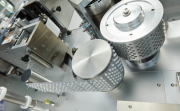 In 1932, Swedish chemist Arne Ölander observed that a gold-cadmium alloy could be bent when cool but would return to its original shape when heated. 30 years later, William Buehler and Frederick Wang of the US Naval Ordnance Laboratory developed a nickel-titanium alloy that could return to its original shape upon deformation. Here Bernard Zwickler, director of EU Automation GmbH, explores why shape memory alloys (SMAs) have since become a popular material choice in aerospace, civil engineering and biomedical device manufacturing.
In 1932, Swedish chemist Arne Ölander observed that a gold-cadmium alloy could be bent when cool but would return to its original shape when heated. 30 years later, William Buehler and Frederick Wang of the US Naval Ordnance Laboratory developed a nickel-titanium alloy that could return to its original shape upon deformation. Here Bernard Zwickler, director of EU Automation GmbH, explores why shape memory alloys (SMAs) have since become a popular material choice in aerospace, civil engineering and biomedical device manufacturing.
Some metals show the shape memory effect because of a reversible change in their crystalline structure. SMAs have two different phases with different crystalline structures and therefore different properties. During their low temperature phase, also known as martensite, the materials can be bent into different shapes. During their high temperature phase, or austenite, the materials tend to return to their original shape.
Unlike typical material transformations, which involve the diffusion of atoms, the phase change in SMAs occurs by a shear lattice distortion, which is why the change is reversible. They also show a property called superplasticity, which allows them to act almost like rubber when heated.
Support for civil structures
 SMAs have been used in civil engineering as reinforcement for existing structures. For example, after an earthquake a bridge or similar structure can experience unseating. Traditionally, steel cable restrainers, steel rods or shock transmission units would have been used to prevent this. However, because they have a larger elastic strain range and can be brought back to their original position after deformation, SMAs could be a more effective alternative.
SMAs have been used in civil engineering as reinforcement for existing structures. For example, after an earthquake a bridge or similar structure can experience unseating. Traditionally, steel cable restrainers, steel rods or shock transmission units would have been used to prevent this. However, because they have a larger elastic strain range and can be brought back to their original position after deformation, SMAs could be a more effective alternative.
Unfortunately, the price of SMAs is still quite high in comparison to conventional construction materials. Also, the welding of SMAs can be difficult due to its hardness. This is especially true when machining large diameter bars, which are needed in this type of application.
Cardiovascular support
SMAs can even be used in bioengineering applications such as dental wires, metal plates for broken bones and for medical devices that help open clogged veins and arteries. One SMA in particular, Nitinol, a metal alloy of nickel and titanium, exhibits excellent biocompatibility and can therefore be used in the manufacture of coronary stents.
A coronary stent is a mesh tube that is placed inside a narrow or weak artery to restore blood flow and support its structure. Self-expanding stents are manufactured with a diameter larger than the target artery, with a transformation temperature set at around 30 degrees Celsius. The stent is deformed under a lower temperature and is then capable of expanding to its original shape after insertion, once it reaches body temperature.
Small and silent actuation
 What’s particularly interesting is the ability of SMAs to offer actuation, particularly in aerospace applications. Doctor Othmane Benafan, a materials research engineer at NASA’s Glenn Research Center in Cleveland, Ohio, and shape memory alloys team leader says, “By changing the temperature of these metals, you can have them push and pull things to do work. The heat that drives them can come from electrical resistance, can be harvested from engine exhaust heat, or just from passive temperature changes in the environment, which can come from an airplane’s take-off to cruise altitude or from a spacecraft’s hot launch to cold orbital conditions in space”.
What’s particularly interesting is the ability of SMAs to offer actuation, particularly in aerospace applications. Doctor Othmane Benafan, a materials research engineer at NASA’s Glenn Research Center in Cleveland, Ohio, and shape memory alloys team leader says, “By changing the temperature of these metals, you can have them push and pull things to do work. The heat that drives them can come from electrical resistance, can be harvested from engine exhaust heat, or just from passive temperature changes in the environment, which can come from an airplane’s take-off to cruise altitude or from a spacecraft’s hot launch to cold orbital conditions in space”.
This means that a material could be used to create movement at a very low cost. Heat from the engine’s exhaust is already being reused to power the aircraft, but it is now being reused to heat and cool the SMA. As you can imagine, the transformation of SMAs is much quieter than hydraulic, pneumatic or electrical actuation, which is beneficial for passengers onboard.
SMAs are also capable of delivering a large force, typically in a smaller package than traditional actuation. In aerospace applications, this means that they can be fitted in smaller spaces, perhaps nearer wing edges. Using SMAs also reduces on-board part count as fewer pumps, gears, fluid and seals are required. As the part count goes down, so does the risk of part failure.
Over 50 years since Buehler and Wang developed the first shape memory alloy, the materials category has certainly proven its brilliance. As the capabilities of SMAs for actuation are explored further, they could even become commonplace in industrial manufacturing spaces. However, it’s unlikely that traditional motor technology will fall by the wayside any time soon.
